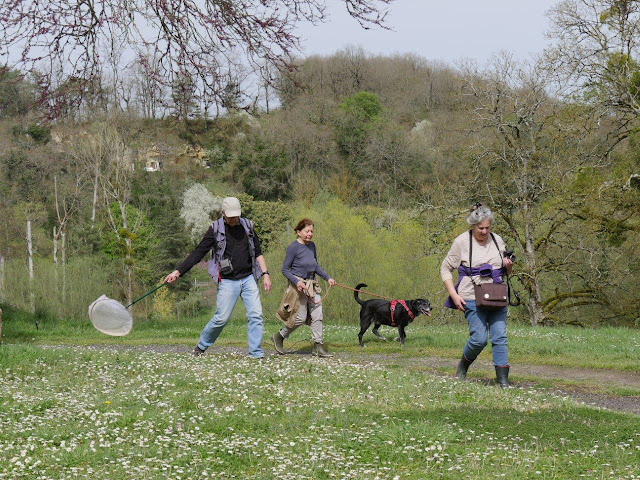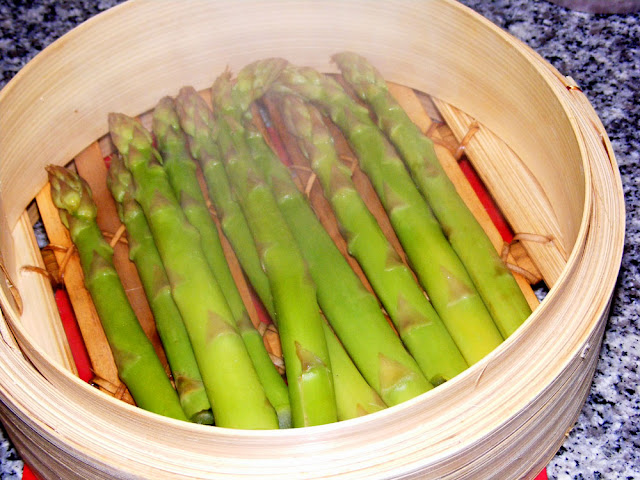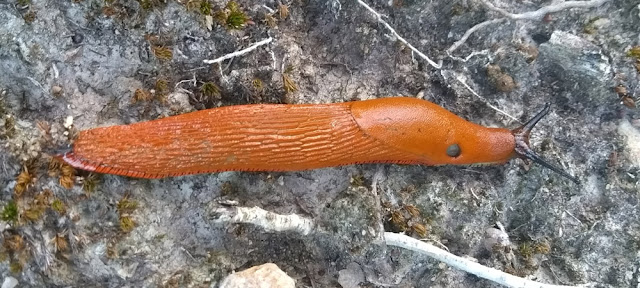Friday 19 April 2024
Traffic Calming in Etableau
Thursday 18 April 2024
Lamb Curry and Weird Rice
It's a super easy recipe, even if it reads a bit complicated. The level of spice was spot on, and the rice actually cooked fully and wasn't just hard pellets. I'm not usually a fan of any sort of rice cooked in a frying pan, but this was good.
Wednesday 17 April 2024
Rare Adders Tongue Fern in the Orchard
Adder's Tongue Fern Ophioglossum vulgatum (Fr. Langue de serpent).
Five years ago I could hardly believe my eyes! A rare and protected fern suddenly appeared in the orchard. I had no idea where it had come from and I'd never seen it before anywhere, despite spending lots of time with botanists and seeing many rare and protected plants here.
This year I'm thrilled to see that the Adder's Tongue is everywhere in the orchard, stretching in a broad band from north-east, where the original station is, to south-west, up under the sour cherries. I've never seen so many individual plants of it.
My serious botanist friends ask me every year if the Ophioglosse has reappeared. This year I sent them all an email to let them know.
Tuesday 16 April 2024
Lichen Outing to the Chateau de Brou
Here are some photos from the Botamyco37 outing to the Chateau de Brou yesterday. We were focusing on lichen, but there were some interesting insects too. As ever, Marie-Claude did a great job of organising and providing expert field teaching.
 |
| Patrick, Marie-Christine and me in action. Photo courtesy of Louisette Chaslon. |
Violet Oil Beetle Meloe violaceus (Fr. Meloe violet), mating. Male is below, female above. He is eating a buttercup stem, one of their favourite foods. These beetles are the object of some conservation concern as their numbers are declining.
Marie-Claude, left, introducing us to the startling white lichen called Sporodophoron cretaceum, almost entirely restricted to oak trunks, and identifiable because it reacts by turning yellow when potassium is applied.
Many lichenologists favourite little lichen, the uncommon Goldeneye Teloschistes chrysophthalmus (Fr. Œil d’or). It is always found on twigs, and likes being in the wind. It is very sensitive to pollution, so has been in decline in Europe for decades.
Trox sp, a hide beetle that I was lucky to see. They are uncommon, and live in birds nests, eating dessicated organic matter. I think it is quite rare to see one trundling about in the open, and I had to ask for help in identifying it (many thanks Philippe Zorgati).
Variospora aurantia a lichen of limestone, which we found on the stones of the chateau itself. It can be distinguished from its lookalike and very common cousin V. flavescens by looking at the lobes of the thallus (ie the wavy outer edge of the lichen). V. aurantia has flattened lobes, a bit like spatulas; V. flavescens has rounded lobes, a bit like fingers.
Black Shield lichen Tephromela atra var calcarea, something of an old friend for me, as I remember learning this one on a previous outing led by Marie-Claude. This variety is very common on limestone, but there is another variety that grows on flint, and another one that grows on tree bark.
A mating pair of the fever fly Dilophus antipedalis. These are in the family Bibionidae, and typically there is sexual dimorphism like this, with females being larger and having long heads with small eyes. Males have large eyes and are smaller. This pair were just a few millimetres long.
 |
| Me trying to photograph the flies. Photo courtesy of Louisette Chaslon. |
We don't often have somewhere so grand for the outing leader to do their introduction. We are very grateful to the Chateau's owners for allowing us access.
Dark-edged Bee Fly Bombylius major (Fr. Grand Bombyle), female, which was lurking around a Common Furrow Bee Lasioglossum calceata colony, waiting its chance to lay eggs in the bees' nests.
Monday 15 April 2024
Touraine Asparagus
 |
| Steamed green asparagus. |
At the end of April and the beginning of May, asparagus is the flagship product on people's plates at home and in restaurants. This year, because of the weather, producers are expecting a bumper crop.
 |
| Locally produced white asparagus at the market. |
The epitome of seasonal produce, asparagus features on the shelves between April and June. In Indre et Loire one finds Touraine asparagus, especially grown around Bourgueil and Richelieu. The label 'Coeur de Touraine' is the most prized, only held by 17 producers around Richelieu, who produce between 200 and 250 tonnes per annum, depending on the year, with 90% white asparagus and the rest green.
 |
| Locally produced green asparagus at the market. |
Did you know that whether white, green or purple it is all the same plant? The colour depends on the method of cultivation. White asparagus grows underground, with out seeing the sun's rays. Purple asparagus is the same variety as the white, but the tip emerges from the soil to see the sun, which gives it the purple colour. Finally, the green grows entirely in the fresh air.
 |
| White asparagus from Braslou, near Richelieu. |
Personally I never buy asparagus from the supermarket, always from a local producer who I can trust to have cut the stems no more than 24 hours before bringing his asparagus to market. According to my asparagus producer of preference, asparagus in the supermarket has been cut about three weeks before it hits the shelves, due to how the supermarket supply chains work. This means it has lost moisture and its sugars have converted to starches, meaning it is a less tasty, tougher vegetable.
Friday 12 April 2024
Monster Molluscs You Could See in the Touraine Loire Valley
The Touraine Loire Valley is home to some impressively large land snails and slugs.
This Yellow Cellar Slug Limacus flavus (Fr. Limace des caves) and its family live in our kitchen. They are nocturnal, so we rarely see them. For scale, the tiles are 20 cm².
I encounter Ash-black Slugs Limax cinereoniger (Fr. Grande limace) in the larger well established forests. They can be pale and stripey like this one...
Red Slugs Arion rufus (Fr. Grande loche) can be encountered anywhere -- in the forest, on waste ground, in gardens and often on roads, paths and tracks.
























